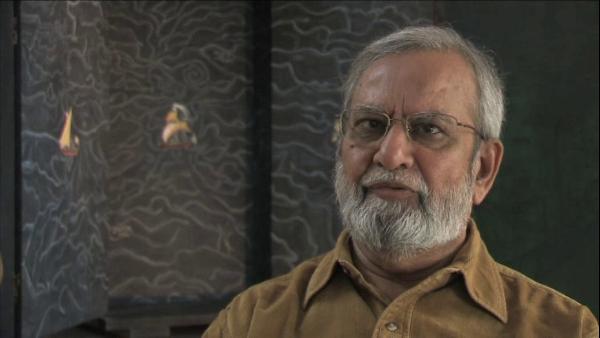NEXT STORY

Speaking in many tongues
RELATED STORIES

NEXT STORY

Speaking in many tongues
RELATED STORIES


|
Views | Duration | |
|---|---|---|---|
| 41. About my paintings (Part 1) | 51 | 08:33 | |
| 42. About my paintings (Part 2) | 37 | 07:23 | |
| 43. Creating panels for The Times of India office | 24 | 03:15 | |
| 44. Speaking in many tongues | 52 | 06:35 | |
| 45. Maps and palimpsests in my work | 63 | 06:55 | |
| 46. Inter-faith marriages and difficulties being a Muslim | 70 | 05:16 | |
| 47. City for Sale | 72 | 03:16 | |
| 48. Teaching and painting | 27 | 05:22 | |
| 49. Salman Rushdie and magic realism | 51 | 03:30 | |
| 50. Exhibition in Paris and stories in my work | 36 | 06:19 |


I was invited to make panels for an office in The Times of India. I am rather wary of doing work for, you know, commissioned work, but then I thought why not, let me see. So they showed me the place and I saw there were six offices, all with glass fronts and backs, glass fronts and sides, and the wall at the end sort of had about, it was 7 feet wide and there were six such cabins. So altogether it made 42 feet. So I decided I will use about, you know, a scale of 3.6, that is half the size of the width, and make six panels. The idea was that if you are sitting in a glass cabin you should be able to see through, and the one who sits in cabin three should be able to see the painting in two as well as in four, and if you walk out, then you would be able to see one by one all six. But I sort of made it sort of more complicated by dividing into vertical zones of sort. So there are multiple kind of divisions, some are wide, some are narrow, there are some who have images, some have landscapes, some have mythical things, some have something very realistic. So it is altogether there are six panels, so I thought that these zones of wonder would be useful. You know, even people sitting and doing their work, they may also peep into the other and they may connect with each other. So the painting makes up as a kind of point of contact, and then they could put it together and see it as a mural if they wish to. Otherwise, there are even zones within that in which they could perhaps find their own imagery that they are interested in. So that is how it was worked out, and each one had a title and some referred to some or other odd story, some referred to local instances, some referred to music, you know, they are an idea that if people listen to music while working, I think painting can also be part of that experience. Unfortunately I must admit here that The Times of India’s administration was rather insensitive. At a later stage one of the paintings was auctioned off. So something which I designed as one single unit, there are six panels which unfortunately was, you know, I was not very happy about it, but then what can you do, you know, when people own it, they do what they like.
Gulammohammed Sheikh is an Indian painter, writer and art critic who has been a major figure in the Indian art world for half a century. His artistic career is closely associated with the renowned MS University of Baroda in Gujarat where after gaining his Master's degree, Sheikh went on to teach in the Faculty of Fine Arts, and where he was appointed Professor of Painting in 1982.
Title: Creating panels for The Times of India office
Listeners: Timothy Hyman
Timothy Hyman is a graduate of Slade School of Fine Art, London, in which he has also taught. In 1980 and 1982, he was Visiting Professor in Baroda, India. Timothy Hyman has curated many significant art exhibitions and has published articles and monographs on both European and Indian artists.
Duration: 3 minutes, 15 seconds
Date story recorded: December 2008
Date story went live: 18 November 2010